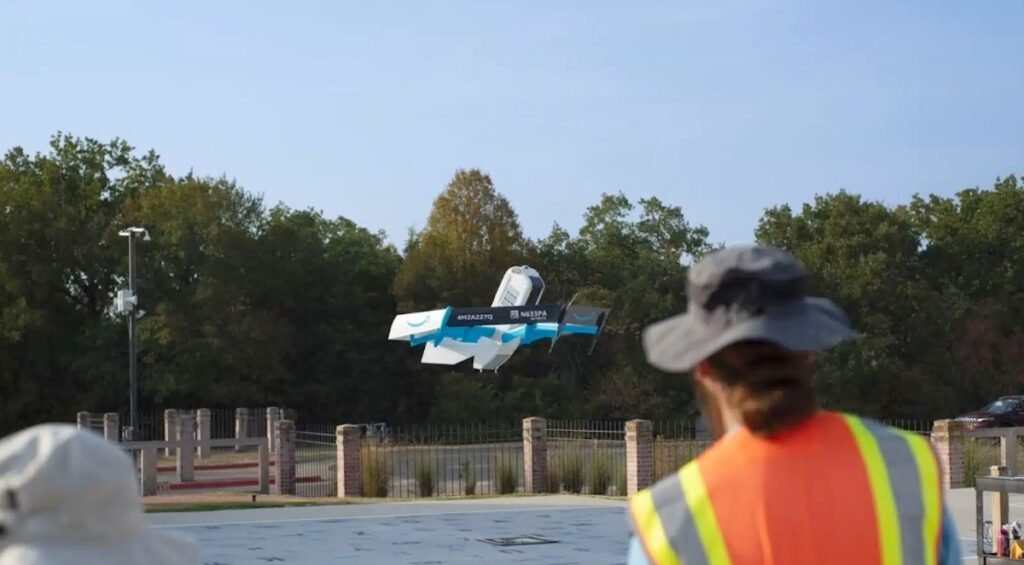
Amazon Drone Delivery Photo by Dronexl
Amazon’s latest MK30 drones are changing the landscape of last-mile delivery, offering customers in select Phoenix areas a faster, more efficient way to receive packages. With FAA approval for beyond visual line of sight (BVLOS) operations, Amazon’s new service represents a milestone in delivery innovation, allowing drones to deliver packages without requiring direct visual contact from the operator. This advancement positions Amazon as a leader in drone delivery and could set the standard for automated, high-speed delivery in urban and suburban areas.
From Concept to Real-World Application
Amazon began its drone delivery journey nearly a decade ago with the launch of Prime Air, a division dedicated to pioneering drone technology. Initial trials took place in the UK, aiming to deliver packages within 30 minutes. However, technical and regulatory challenges delayed widespread implementation, with noise complaints, FAA restrictions, and company layoffs slowing progress. Now, the FAA’s recent BVLOS authorization is enabling Prime Air to expand, deploying drones that fly at altitudes up to 400 feet and hover at 12 feet to deliver items.
The MK30 Drone: What Makes It Different?
The MK30 drone is Amazon’s most advanced model yet, designed to fly twice as far as its predecessor and in a wider range of weather conditions, including light rain. Equipped with enhanced safety features and quieter operation, the MK30 is built to handle packages up to five pounds and can cover a 7-mile radius from Amazon’s Tolleson, Arizona facility. The drone’s intelligent “detect and avoid” system further enhances safety by allowing it to navigate around obstacles autonomously.
For customers, the convenience is immediate. Prime members can opt for drone delivery of everyday essentials—ranging from tech and office supplies to household items—for a fee of $9.99, with non-members paying $14.99. Amazon’s streamlined drone operations in hybrid same-day facilities, which combine fulfillment and delivery stations, optimize efficiency and speed, making it possible to deliver packages within an hour.
Real-World Applications: Drone Delivery in Action
Beyond everyday essentials, Amazon’s drones are also making strides in medical deliveries. In College Station, Texas, MK30 drones are used to transport prescription medications, providing quick access for patients with limited mobility. This specialized application demonstrates the technology’s potential to meet critical needs, especially in rural or remote areas.
Other companies are also entering the drone delivery arena, each exploring different niches. While Walmart focuses on groceries and Walgreens on prescriptions, Amazon’s broad range of delivery items—from household essentials to tech gadgets—gives it a unique edge in the consumer market.
Expert Opinions on the Future of Drone Delivery
Industry experts believe Amazon’s recent FAA approval could set a precedent for other companies seeking to expand their drone services. Zoe Richmond, an Amazon spokesperson, notes that the BVLOS approval “marks the next chapter in scaling drone delivery.” Analysts predict that drone delivery could reduce costs associated with last-mile delivery, which remains one of the most expensive parts of the logistics chain.
However, drone delivery is not without its challenges. Regulatory hurdles, safety concerns, and public acceptance all pose obstacles. According to transportation analyst Michael Ramsey, “The success of Amazon’s drone program will depend on how well it can address these issues, especially as they expand into densely populated areas.”
How to Use Amazon’s Drone Delivery
- Check Your Eligibility: Amazon’s drone delivery is currently limited to specific areas within Phoenix and Texas. Eligible customers can choose drone delivery for items under five pounds.
- Select Drone Delivery at Checkout: Choose drone delivery for qualifying items when prompted during checkout, and select your preferred landing area.
- Expect Timely Delivery: Delivery takes less than an hour, provided the weather conditions are favorable. Notifications will keep you updated on the progress of your delivery.
Benefits and Challenges of Drone Delivery
The most obvious benefit of Amazon’s drone delivery service is speed. Aimed at busy customers, this service is designed to save time by eliminating the need to wait for traditional delivery. However, the cost of drone delivery may be prohibitive for some, and weather limitations, such as high winds or rain, can impact reliability.
Environmental impact is another consideration. The MK30’s ability to fly on electric power reduces emissions compared to gas-powered vehicles, aligning with Amazon’s commitment to sustainability. Still, large-scale implementation would require substantial energy and could increase demands on the power grid.
Reflecting on the Future of Drone Delivery
Amazon’s advancements raise questions about the future of delivery and the role of autonomous vehicles in everyday life.
- Will drone delivery become the norm, or will it remain a premium option for select customers and areas?
- Could drones help reduce traffic congestion by removing delivery vans from the road?
These developments prompt us to consider how convenience and innovation can coexist with safety and environmental sustainability.
As Amazon continues to push boundaries in drone delivery, one thing is clear: the future of last-mile delivery is on the horizon, flying right to our doorsteps.




